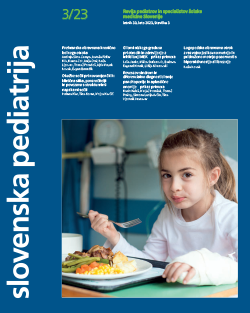
|
Article short contents
Slovenska pediatrija 2023; 30: 124-130
https://doi.org/10.38031/slovpediatr-2023-3-02en
|
: 670
Original scientific article
URINARY TRACT INFECTIONS IN NEONATES: CLINICAL PRESENTATION, CAUSATIVE AGENTS, AND ASSOCIATION WITH STRUCTURAL URINARY TRACT ANOMALIES
Helena Klar
Splošna bolnišnica Murska Sobota, Murska Sobota, Slovenija
Tina Koren
Zdravstveni dom Murska Sobota, Murska Sobota, Slovenija
Mojca Kavčič
Klinični oddelek za neonatologijo, Pediatrična klinika, Univerzitetni klinični center Ljubljana, Ljubljana, Slovenija
Abstract
Background: Urinary tract infections occur more often in newborns than older children. With our research, we wanted to analyze the clinical picture and the connection with structural abnormalities of the urinary tract and create an overview of the disease agents and their sensitivity to antibiotics.
Methods: The retrospective study included hospitalized newborns due to urinary tract infections at the Clinical Department for Neonatology of the Paediatric Clinic between 2013 and 2021. Data were obtained using the Clinical Information System.
Results: This research included 274 newborns, of which 69% were boys. The percentage of patients with associated urinary tract anomalies was 39,8%. Clinical signs upon admission were nonspecific; the most common were fever (37.1%), poor feeding (21.5%) and irritation or inconsolable weeping (17.1%). The most commonly discovered pathogen was Escherichia coli (E. coli) (60.4%). Antibiotic treatment was primarily given in the parenteral form (74.8%) and lasted, on average, 9,6 days, with a median of 7 days. The most commonly chosen empiric antibiotic therapy was therapy with ampicillin and gentamicin (61.3%). In 36.5%, the isolated bacteria were resistant to one of the tested antibiotics: Escherichia coli was most often resistant to ampicillin (36.7%) and in 1.8% to gentamicin. Conclusion: Clinical signs of urinary tract infection in neonates are nonspecific. A high percentage of newborns have associated urinary tract anomalies. The average age at the onset of the first signs of the disease is lower in newborns with congenital urinary tract anomalies. In this group of patients, Escherichia coli, as the most commonly isolated pathogen, occurs in a lower percentage and is resistant to ampicillin in a third of the cases and rarely to gentamicin.
Key words: urinary tract infection, newborn, urine culture, Escherichia coli, congenital abnormalities, antibiotic resistance